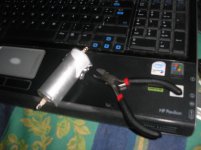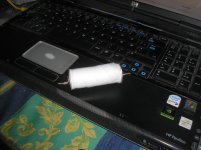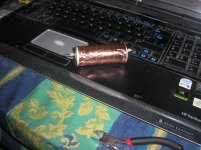I always threw thoose connectors away from the beginning.
Man, I wish I had. Like to give me a heart attack when I lost that channel.🙁
Luck it was not worse 🙂
I do not think I got answer for my question about change in sound decreasing the shunts resostors from 5 to 2,2 ohm.
I do not think I got answer for my question about change in sound decreasing the shunts resostors from 5 to 2,2 ohm.
Luck it was not worse 🙂
I do not think I got answer for my question about change in sound decreasing the shunts resostors from 5 to 2,2 ohm.
Its anecdotal, but some users really recommend more is good, some others can't hear much difference beyond 200mA when they appreciate the jump from 60mA to 200mA.
Thank You Salas 🙂 Also I think the Kiwame will change the sound from a bit to bright to warm .
I don't seem to find brand to make much of a difference for CCS resistor as far as brightness.
But lower is better. I use 2R right now, and will go to 1.5R when I get an opportunity to re-box DCB1 in the fancy case you recommended 😉
Each iteration causes better focus in soundstage going from 10R to 3.3R to 2R.
But lower is better. I use 2R right now, and will go to 1.5R when I get an opportunity to re-box DCB1 in the fancy case you recommended 😉
Each iteration causes better focus in soundstage going from 10R to 3.3R to 2R.
I found the signal path to influence brightness.
Kiwame Carbons, too rough, maybe lush sounding.
Takman carbon films were really bright in my system.
PRP's seem to be the closest to all around best, only bettered by TX2575, and only in the 220R position.
I've used the MK132 Caddocks before in 220K and 1M positions, they do well there, adding a slight wooden tone to the mix, if desired. But all these resistors are expensive and results may vary. I would like to try the Takman Rey sometime, heard good reports on them - but not easy to get in US.
Kiwame Carbons, too rough, maybe lush sounding.
Takman carbon films were really bright in my system.
PRP's seem to be the closest to all around best, only bettered by TX2575, and only in the 220R position.
I've used the MK132 Caddocks before in 220K and 1M positions, they do well there, adding a slight wooden tone to the mix, if desired. But all these resistors are expensive and results may vary. I would like to try the Takman Rey sometime, heard good reports on them - but not easy to get in US.
Its anecdotal, but some users really recommend more is good, some others can't hear much difference beyond 200mA when they appreciate the jump from 60mA to 200mA.
In my system the jump from 200 to 500 was quite noticeable -- I use the Russian Teflon in the 0.22uF position. This is very different from the MKP. To my ear, more neutral/less presence.
I also think Teflon Ft 3 are good. But they are better if you replace aluminimum housing with copper tape. Have you tried pure polypropylene ?
Aren't the wima poly pro?
How do you remove the casing? Right now, it is a good path to ground and it can be safely squeezed against the case to hold in place. The case is at earth potential.
How do you remove the casing? Right now, it is a good path to ground and it can be safely squeezed against the case to hold in place. The case is at earth potential.
Now the voltages across the ccs resistors are 1.625 and 1.652. Close enough. There is less vibration from the transformer. It sounds fine. Better? Maybe a little. It was 1.3 and 1.6 across 3 ohms.
will try a lower value ccs resistor now.
will try a lower value ccs resistor now.
Could have some small positive effect by loading the transformer halves more equally at such substantial draw level.
Last edited:
What if it were vacuum packed?
What about the hermetic sealing?
What is/was the moisture content of the working environments?
What about the hermetic sealing?
What is/was the moisture content of the working environments?
I like the pins for the early stages of testing. Convenient when many disconnections are required, between power ups, different loadings, etc.At this point I may just switch those connectors to soldered-on wires.
Finally, the in/out wiring can be soldered to the exposed pins. Saves risking damage to the PCB traces/pads.
View attachment 416180
View attachment 416181
View attachment 416182
At last I seal it with Shellac. I loudspeakers this is magic.
I did something similar, but used a routed piece of wenge wood as a case, and filled the remaining hole with beeswax.
Measurements remained absolutely the same, including Q, even after a few months
And improvement was rather big. I never have used it with big ones, just with 10nF ones on my Shigaclone for now, but I will definitely try it on my DCB1 caps as well at some point. For now my chassis needs redesign and I do not have the space in it.
What if it were vacuum packed?
What about the hermetic sealing?
What is/was the moisture content of the working environments?
It was not hermetic. There was holes in the alu. Teflon do not need that I think. Now it is less resonant and hermetic sealed.
Before the sealing was paramagnetic now it is diamagnetic.
Last edited:
Congrats. It was suspect case 1, connections.
Has anyone changed those signal connectors to another kind of connector? what did you use?
thanks.
View attachment 416180
View attachment 416181
View attachment 416182
At last I seal it with Shellac. I loudspeakers this is magic.
Thanks for the photos! A picture is worth a thousand words.
- Home
- Source & Line
- Analog Line Level
- Salas hotrodded blue DCB1 build


